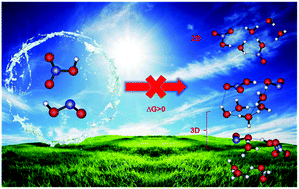The structural and thermodynamic properties of the (HNO3)(HONO)(H2O)n (n = 1–6) clusters have been investigated via density functional theory on the M06-2X/6-311+G(2d,p) level. Atoms in molecules (AIM) analysis, reduced density gradient (RDG) and natural bond orbital (NBO) were employed to investigate the non-covalent interactions of two acid hydrates, which show that these clusters are bonded with hydrogen bonds having diverse intensities. In addition, the thermodynamic data show that clusters are formed exothermically and non-spontaneously. The study of temperature effects on the isomer ordering suggests that the distribution of the isomers depends on the temperature. Moreover, the optical properties show that the isotropic mean polarizability and Rayleigh light scattering intensity have a linear relationship and second-order correlation with the cluster size, respectively. The higher evaporation rate (∼1010 s−1) implies that these clusters will evaporate rapidly once they are formed. Therefore, HONO cannot spontaneously form a stable cluster with HNO3 and water molecules in the atmosphere, which is unlike HCl, HOCl, or H2SO4. This study may provide insight into the role of HONO in the initial steps of new particle formation on the molecular scale, and and provide understanding on the properties of nitrogen-containing acid aerosol.

